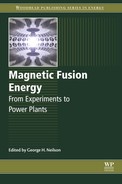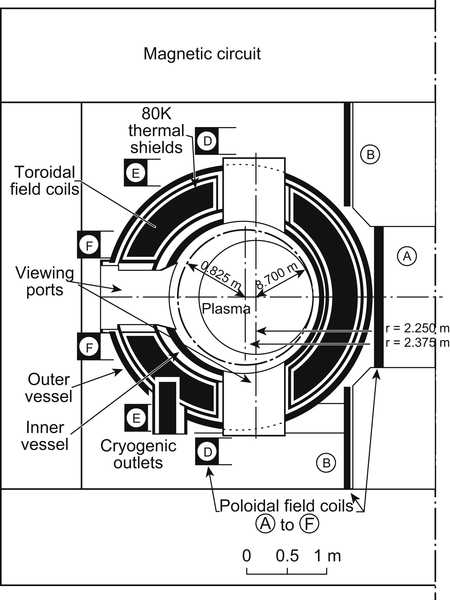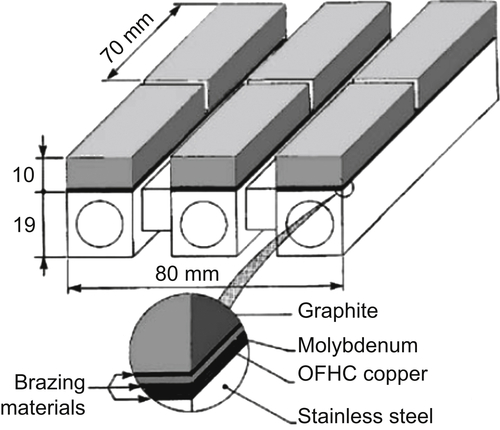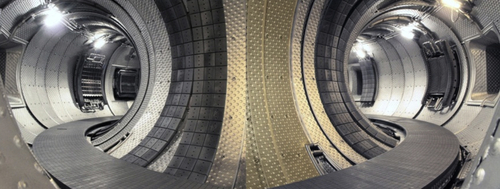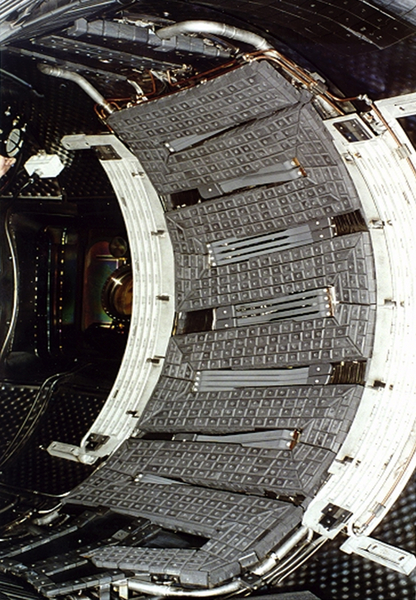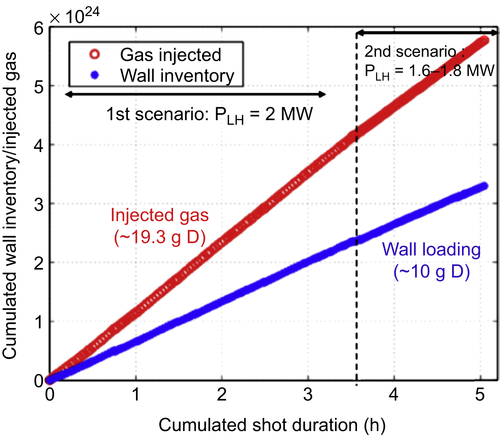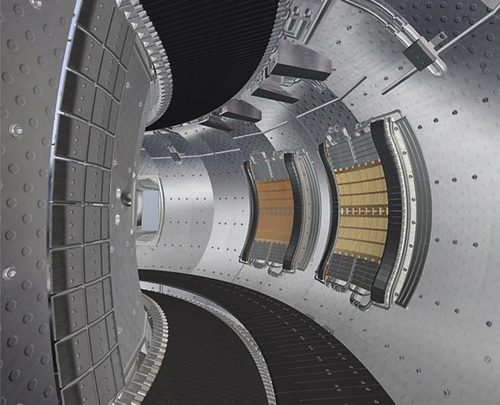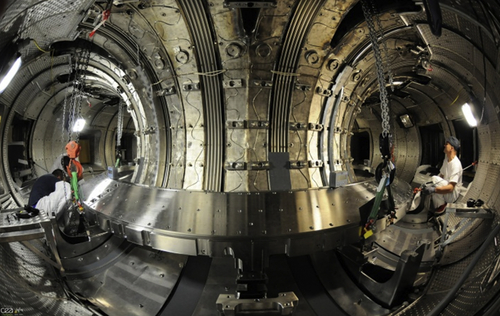Tore Supra—WEST
Abstract
Tore Supra, which began operating in 1988, was the first large tokamak to integrate all the technologies required to produce long pulse duration plasmas: superconducting magnet and cryogenic system, actively cooled plasma facing components and pressurized water loop, powerful heating and current drive systems, pump limiters and real-time protection and control capabilities. Significant achievements in all these technological areas have allowed for progressively improving the level of performance and addressing key operational issues. The 30 s initial objective has been greatly exceeded and in December 2003, the CEA-Euratom installation reached a record plasma pulse that lasted 6 minutes and 30 seconds, with 500 kA plasma current, holding the record for the energy injected/extracted from a pulse at 1.1 GJ. As a result of the technological success, important physics phenomena which govern steady-state plasma control have been investigated in depth such as current diffusion, thermal equilibrium of the plasma facing components, plasma-wall particle exchanges. Demonstration of fully non-inductive plasma scenario over very long duration and assessment of fuel retention in carbon wall are among the most noteworthy.
Today, to support ITER construction and operation, Tore Supra is undergoing a major change with its transformation into WEST (acronym for W (chemical symbol for tungsten) Environment in Steady-state Tokamak). To be in line with ITER, the circular poloidal cross-section of the plasma and the limiter configuration are turned into a D-shape poloidal cross-section of the plasma and a divertor configuration while the carbon is abandoned in favor of tungsten as plasma facing material. Armed with these elements, WEST is targeted at paving the way towards the ITER actively cooled tungsten divertor procurement and operation and mastering integrated plasma scenario over relevant plasma wall equilibrium time scale in a metallic environment.
Keywords
Divertor; Limiter; Long pulse operation; Plasma-facing components; Superconductivity; Tokamak; Tore Supra; WEST9.1. Background and objectives of Tore Supra
9.2. Plant overview
Table 9.1
Main characteristics of the Tore Supra tokamak


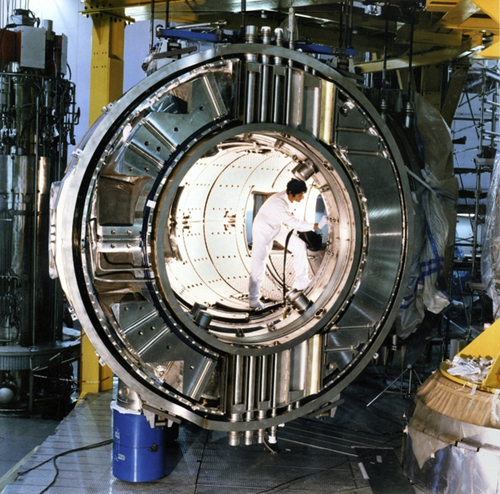
Table 9.2
Tore Supra additional heating and current drive systems
| System | Frequency | Source power (MW) | Maximum power coupled to the plasma (MW) | Maximum energy injected in one discharge (MJ) |
| Ion cyclotron | 40–80 MHz | 12 | 10.5 | 265 |
| Lower hybrid | 3.7 GHz | 8 | 6.2 | 1070 |
| Electron cyclotron | 118 GHz | 1 | 0.8 | 25 |

Table 9.3
Characteristics of the different fueling systems used on Tore Supra
| Continuous pellet injector | Centrifugal pellet injector | Two-stage light-gas gun pellet injector | Supersonic molecular beam injector | |
| Period of use | 1989–97 | 1991–99 | 2003–11 | 2002–11 |
| Number of pellets or pulses per discharge | 100 | 1 | Unlimited | Unlimited |
| Maximum frequency (Hz) | 5 | – | 10 | 10 |
| Pellet or beam speed (m/s) | 500–600 | Up to 4500 | 200–900 | 2000 |
| Atoms per pellet or per pulse (×1020) | 2–13 | 3.5–13 | 2–6 | 0.5–10 |
| Typical reliability (%) | 70 | 98 | 98 | 100 |

9.3. Main achievements
9.3.1. Superconducting magnet
Table 9.4
History of Tore Supra superconducting Toroidal Field (TF) system
| Period | Phase of operation |
| 1982–88 | Coils manufacture and magnet assembly All coils tested at 1400 A at CEA Saclay |
| 1988 | Acceptance test of the TF system at CEA Cadarache up to 600 A First plasmas Short circuit on coil BT17 |
| 1989 | Replacement of BT17 by spare coil BT19 Acceptance test of the TF system up to 1450 A (9.3 T on conductor) Quench of BT13 during an FSD from 1450 A Quench of BT4 during severe disruption |
| 1989–95 | Operation of the TF system at 1250 A Abnormal overheating in BT13 during FSD Repair and test at CEA Saclay of BT17 |
| 1995–2002 | Disappearance of abnormal overheating in BT13 during FSD after a thermal cycling between low temperature and room temperature Operation of the TF system at 1250 A |
| 2002–11 | Continuous data acquisition system in operation Long and energetic plasma discharges |
9.3.2. Development of actively cooled plasma facing components
Table 9.5
Main characteristics of the actively cooled plasma facing components operated in Tore Supra; main limiters are underlined
| Component area and location | Material, power handling capability, particle control structure | Upgrade and/or significant event | Period of use |
Inner first wall; 12 m2; located on the high field side | Graphite tiles brazed on stainless steel heat sink 12-MW steady-state (at least 1 MW/m2) No particle collection | Some panels replaced with improved panels with CFC tiles in 1996 | 1988–99 |
| 6 modular pump limiter; 0.16 m2 each; located at the bottom of the vacuum vessel | Graphite brazed on CuCrZr tubes 0.7-MW steady-state each (10 MW/m2 at the leading edge) Throats for particle collection | Only 4 installed Test of particle collection with vented structure One pierced by runaway electrons | 1988–99 |
| 1 modular pump limiter; 0.3 m2; located at the midplane of the low field side | Graphite tiles brazed on copper tubes 2-MW steady state (10 MW/m2 on the front face up to 30 MW/m2 on the leading edge) Throats for particle collection | Developed by ORNL (USA) Pierced by runaway electrons | 1993–94 |
| 6 modules of ergodic divertor; 0.4 m2; located at the midplane of the low field side | Graphite tiles bolted on front face and brazed on neutralizers (OHFC plate) 1-MW steady-state each (10 MW/m2) Vented structure for particle collection | Upgrade of the structure in 1996; CFC tiles on front face and B4C coating on neutralizer tubes (CuCrZr tubes) 3-MW steady-state each | 1988–99 |
| 10 antenna guard limiters; 0.1 m2; located at the midplane of the low field side | CFC tiles brazed on CuCrZr heatsink 10 MW/m2 No particle collection | Only one ICRH antenna equipped in 1998, 2 ICRH and 1 LHCD in 1999 | 1998–99 2001–11 |
Toroidal pump limiter; 7.5 m2; located at the bottom of the vacuum vessel | CFC tiles brazed on CuCrZr heatsink 15-MW steady-state (10 MW/m2 on the front face up to 18 MW/m2 on the leading edge) Throat for particle collection | First year of operation with 3 sectors out of 12 (competed by inertial graphite tiles) | 2001–11 |


9.3.3. Heating and current drive systems
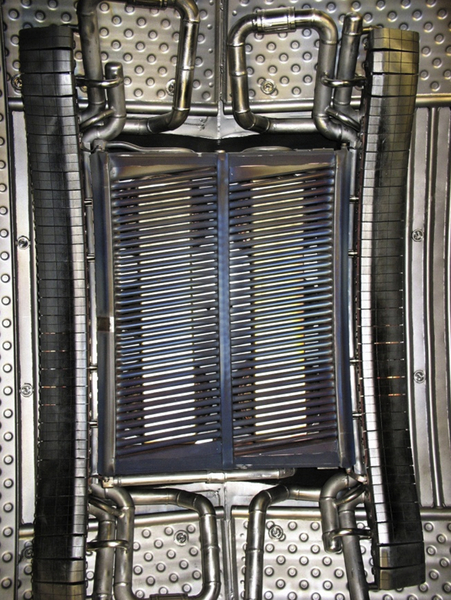
9.3.4. Key ITER operational issues

9.3.5. Ergodic divertor experiments
9.3.6. Long pulse experiments

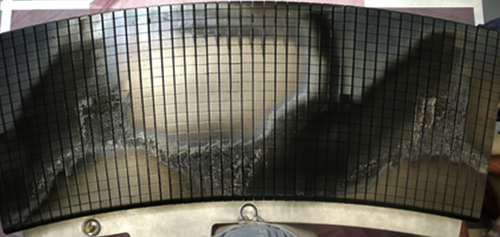
9.4. Preparing ITER operation: the WEST project
9.4.1. From limiter to divertor configuration
9.4.2. From carbon to tungsten PFC


